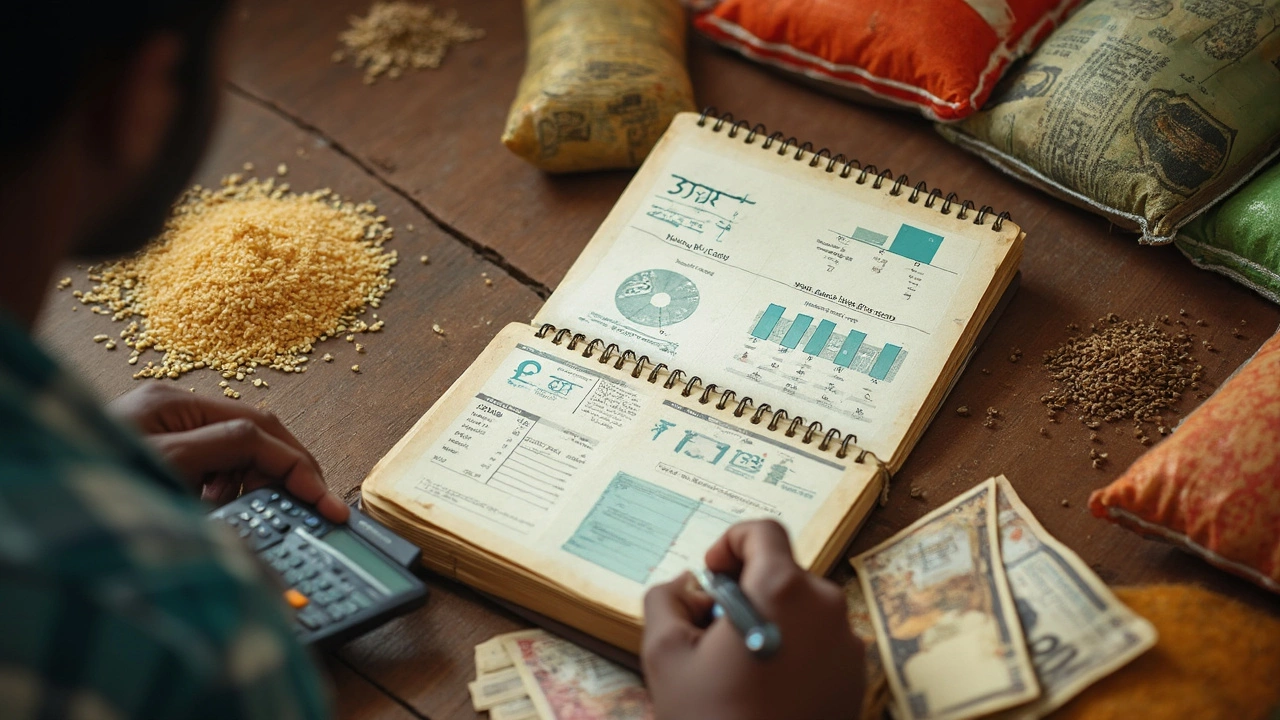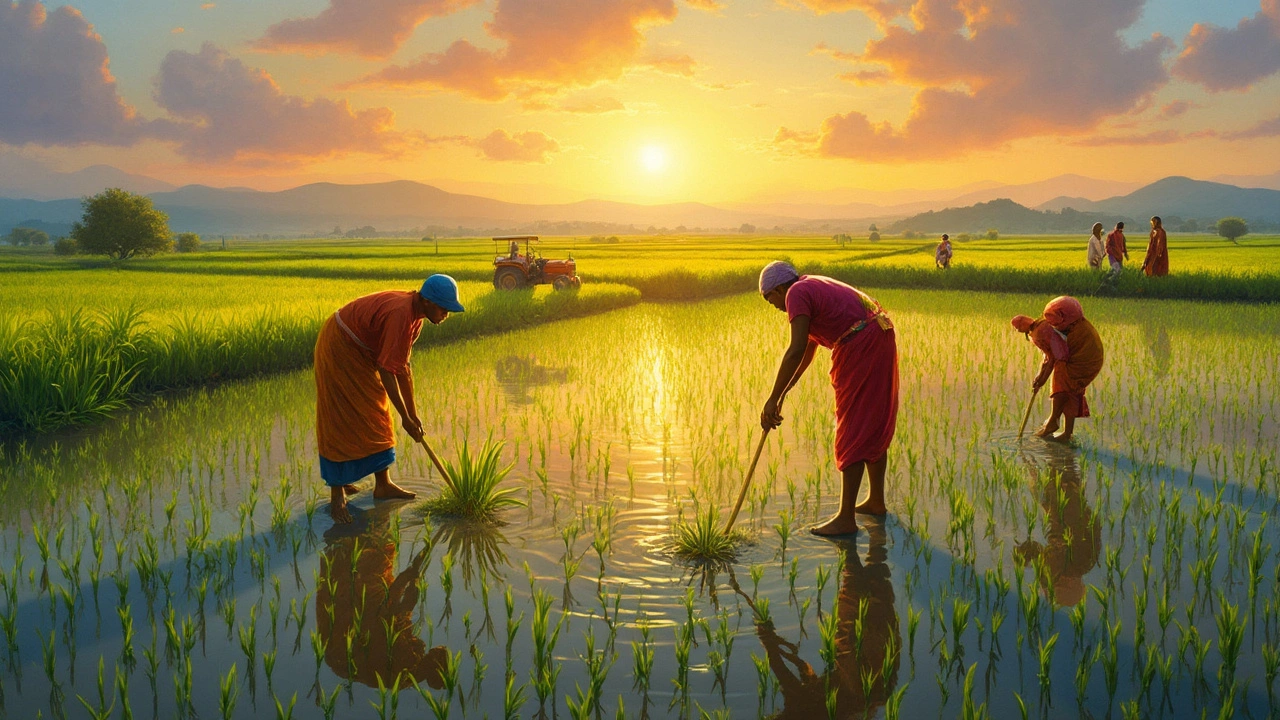Most folks think rice farming is a ticket to easy money—huge fields, big bags of rice, simple math. But if you dig in, the profit picture isn’t so black and white. Raw numbers matter: how much land you have, the cost of seeds and fertilizer, how much you shell out for water, and what you can actually sell your crop for at the end of the day.
The weird part? Rice prices swing with the weather, global politics, and even your neighbor’s farming choices. One bad storm can knock out hundreds of dollars in profit. You might make $300 to $900 per acre one year, then barely break even the next if fertilizer costs climb or bugs hit hard. The upside: Small changes in how you farm—smarter water use, better pest control, newer rice types—can squeeze out a lot more profit than most people guess. So before you throw all your savings into rice fields, let’s get into the numbers and know-how that separate the winners from the ones left paddling in the mud.
- The Numbers: Cost vs. Revenue in Rice Farming
- Major Factors Behind Profitable Rice Harvests
- Smart Moves: Boosting Yields and Cutting Costs
- Selling Your Rice for the Most Money
The Numbers: Cost vs. Revenue in Rice Farming
When folks ask about rice farming profits, the real answer starts with the details on costs and what you can actually earn per acre. There’s no magic guesswork—just the plain numbers.
Here’s what the yearly breakdown looks like in the U.S. for one acre, which is about average for medium-scale growers:
| Expense/Revenue Item | 2024 Typical Cost/Income (per acre, USD) |
|---|---|
| Seed | $35 - $60 |
| Fertilizer | $100 - $200 |
| Pesticides/Herbicides | $40 - $70 |
| Irrigation (Water) | $65 - $120 |
| Field Prep & Machinery | $95 - $150 |
| Labor | $65 - $120 |
| Misc. (insurance, repairs, etc.) | $20 - $50 |
| Total Costs | $420 - $770 |
| Gross Revenue (average yield 7,000 lbs/acre @ $0.15/lb) | $1,050 |
| Net Profit (before taxes) | $280 - $630 |
That profit range can look tempting, but it tells you something crucial: your income could swing by hundreds of dollars just from changes in input prices or weather surprises. Each acre’s return also depends a ton on your yield—higher yield almost always means better profit. For example, every extra 1,000 pounds you get per acre is another $150 in your pocket if rice prices hold steady.
Don’t forget local price differences too. In India or Southeast Asia, seed and labor might cost less, but rice usually sells for less, so profit margins squeeze tighter. Other costs—like field prep or water—can pop up fast if you aren’t careful. And if rice prices fall just a couple cents per pound, you’ll feel it right away come harvest.
So the main thing: track every cost, weigh every option. Talk to neighbors. Find out your area’s real input costs and average yields. The math will either reassure you—or clue you in that you need to sharpen your game before putting money on the line.
Major Factors Behind Profitable Rice Harvests
So, what decides whether rice farming makes you real money, or just covers your bills? It boils down to a handful of super practical things. Most folks talk about land right away. Acreage matters, sure, but there are bigger levers to pull. Let’s look at what really puts more cash in your pocket in this business.
- Rice farming thrives or tanks on water management. Flooded fields help control weeds but cost a lot in fuel and irrigation. Some farmers are switching to alternate wetting and drying methods, which can cut water bills by up to 30% and still protect yields.
- Variety choice makes a huge difference. Hybrid and high-yield seeds give you more grain per acre—some families get up to 30% larger harvests just by picking the right type for their climate. Disease resistance helps too; nobody likes to watch their profits rot away from blight.
- Access to decent fertilizer and smart pesticide use keeps plants healthy. But fertilizer prices can swing wildly. In 2023, U.S. average fertilizer cost was around $139 per acre for rice.
- Labor costs chew up budgets. Family-run farms usually win out here—it’s easier to keep labor costs lower if you’re not hiring out every job.
- Mechanization helps. Tractors, planters, and combine harvesters speed things up, cut labor, and reduce post-harvest losses. Even secondhand equipment saves real dollars over renting every season.
To give you a sense of the moving parts, here’s a snapshot of some main cost and yield drivers in typical U.S. rice farms. Actual numbers swing by region and year but these are solid ballpark figures:
| Factor | Average Value | Notes |
|---|---|---|
| Seed Cost | $32/acre | Depends on standard vs. hybrid |
| Fertilizer/Pesticide | $139/acre | Can spike higher fast |
| Water/Irrigation | $75/acre | Varies on rainfall, price of diesel |
| Average Yield | 7,500 lbs/acre | With good management |
| Labor | $60/acre | Family farms often lower |
Farmers who keep these numbers in check, pick solid varieties, and work with the weather instead of against it—those are the ones with a healthy rice bottom line.

Smart Moves: Boosting Yields and Cutting Costs
Getting more rice from each acre and spending less to do it—that’s really where profit grows. Small tweaks in your routine can pay off way bigger than just pushing for giant harvests. Here’s what works for a lot of folks in the know:
- Rice farming thrives on timing. If you plant too early or too late, you risk bad weather or pests messing up your yield. Most growers see better harvests if they stick close to locally recommended planting windows, matching rainy seasons or irrigation schedules.
- Pick the right variety. These days, short-season hybrids and pest-resistant seeds might cost a bit more upfront, but you’re cutting chemical costs and saving a lot of worries. In India, for example, hybrid rice boosted yields by up to 20% over older varieties without eating into profits with extra inputs.
- Don’t skip soil tests. A basic soil test tells you exactly what your field needs, so you don’t overspend on fertilizers you don’t need. It’s surprising how often farmers buy nutrients the soil already has enough of—literally money in the ground.
- Water management saves cash and rice. Try alternate wetting and drying instead of flooding fields nonstop. Studies from the Philippines showed farmers who used this method slashed water use by 30%, saved on pumping costs, and held onto their average yields.
- Weed early, not often. One solid weeding right after transplanting does more than three half-hearted passes later. Fewer weeds, fewer sprays, less time wasted.
If you want to see where the big savings add up, check this table for typical inputs and their share of total costs:
| Input | % of Total Cost | Cost-Saving Tip |
|---|---|---|
| Seeds | 8% | Use certified varieties and avoid over-seeding |
| Fertilizers | 28% | Base rates on soil tests, split applications across growing season |
| Water/Irrigation | 16% | Alternate wetting & drying, fix leaks early |
| Pesticides/Herbicides | 12% | Pick resistant varieties, spot-treat when possible |
| Labor | 25% | Share equipment, plan team tasks to avoid bottlenecks |
| Other | 11% | Negotiate bulk purchase discounts |
All these choices—using less water, testing your soil, planting smart—mean you keep more of what you earn. It’s less about luck and more about the small stuff you do every season.
Selling Your Rice for the Most Money
If you want the most bang for your buck in rice farming, knowing how to sell your crop is half the game. The price you get for your rice changes fast—it’s all about timing and picking the right sales channel. For example, in 2024, the average price per ton of paddy rice in the U.S. was around $370, but farmers who stored their crop to wait for high-demand months saw prices spike closer to $420 per ton.
Let’s get down to what really moves the needle when you’re selling:
- Timing matters: Rice prices usually rise in the months when fewer new crops are hitting the market (think: late spring or after the main harvest rush). If you can dry and store your rice right, waiting a few months can bump your profit by 10% or more.
- Quality counts: Clean, uniform grains bring premium prices. Broken or mixed rice can fetch 15-30% less, so invest in good cleaning and grading.
- Local vs. direct-to-buyer: If you sell straight to mills or bulk buyers, skip the middleman and earn a better margin—sometimes up to $40 more per ton compared to going through a co-op or broker.
- Add value: Milling, packaging, or offering certified organic rice can make a big difference. Data shows packaged, branded rice often sells for 50% more per kilo, but there’s work (and marketing) involved.
Check out how prices stack up for different sales strategies:
| Sales Channel | Average Price per Ton (USD) | Extra Costs |
|---|---|---|
| Bulk Sale to Mill | $370 | Transport |
| Direct to Retailer | $410 | Packing, Delivery |
| Packaged/Branded Rice | $520 | Packing, Branding, Licensing |
Once, with Liana’s help, I sealed a quick deal at harvest just to have some cash on hand. But looking back, if we’d hung onto that crop and titled it for premium buyers, that same rice would’ve paid for our next seed order twice over. That’s how much timing and the right buyer can change your bottom line.
It’s a bit of a hustle. Good network, keeping an eye on local and global prices (watching sites like Rice Outlook), and knowing when to hold or when to sell—all can put extra money in your pocket at the end of the season.





